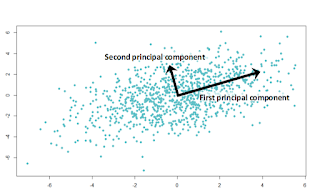Notes on Convex Optimization
1.1 Sub-level sets.
- Definition: The $\alpha$-sublevel set of a function $f$ contains all the feasible input $x$ of $f$ having the value $f(x)<=\alpha$.
- Properties: Sublevel sets of a convex function are convex for all $\alpha$ ($f(x) \leq \alpha$, $f(y) \leq \alpha$, $f(\theta x + (1-\theta) y) \leq \alpha $). If $f$ is concave, then its $\alpha$-superlevel set is a convex.
- Usage: To establish convexity of a convex set by associating it as a sublevel set of a convex function or a superlevel set of a concave function.
1.2 Epi-graph.
- Definition: epi f = $\{ (x, t) | x \in dom f, f(x) \leq t \}$. Epi means 'above'.
- Properties: A function is convex iff its epigraph is a convex set. A function is concave iff its hypograph is a convex set.
- Usage: Many results for convex functions can be proved (or interpreted) geometrically using epigraphs, and applying results for convex sets.
1.3 Closed set.
- Definition: A set is closed if it contains its boundary.
1.4 Closed function:
- Definition: a function is closed if its epi-graph is a closed set.
1.5 Conjugate functions.
- Definition: Let f: $R^n \rightarrow R$, $f^*:R^n \rightarrow R$ is defined
$$ f^*(y) = sup_{x\in dom f}(y^Tx - f(x))$$
- Properties:
+ $f^*$ is a convex function whether f is or is not convex.
+ Fenchel's inquality: $f(x) + f^*(y) \geq x^Ty$
+ Second conjugate: if $f$ is convex, $f$ is closed, then $f^{**} = f$.
+ Legendre transform: the conjugate of a differentiable function $f$ is also called the Legendre transform of $f$. Let $z \in R^n$ be arbitrary and define $y = \nabla f(z)$, we have $f^*(y) = z^T \nabla f(z) - f(z)$.
+ Scaling and composition with affine transformation.
+ Sums of independent functions: if $f(u, v) = f_1(u) + f_2(v)$, $f_1$, $f_2$ are convex functions with conjugates $f^*_1$ and $f^*_2$, then $f^*(u, v) = f^*_1(u) + f^*_2(v)$.
1.6 Strong convexity and implications
- Definition: an objective function is strongly convex on $S$, which means there exists an $m > 0$ such that $\nabla^2 f(x) \succeq m I$, for all $x \in S$.
- Properties:
+ For $x, y \in S$, we have $f(y) = f(x) + \nabla f(x)^T (y-x) + \frac{1}{2}(y-x)^T\nabla^2 f(z) (y-x)$, for some $z$ on the line segment $[x, y]$.
+ By the strong convexity assumption, the last term on the RHS is at least $(m/2)\|y-x \|^2_2$. So we have the inequality $f(y) \geq f(x) + \nabla f(x)^T (y-x) + \frac{m}{2}\|y-x\|^2_2$, for all x and y in $S$. When $m = 0$, we recover the basic inequality characterizing convexity; for $m > 0$, we obtain a better lower bound on $f(y)$ than follows from convexity alone.
- Definition: The $\alpha$-sublevel set of a function $f$ contains all the feasible input $x$ of $f$ having the value $f(x)<=\alpha$.
- Properties: Sublevel sets of a convex function are convex for all $\alpha$ ($f(x) \leq \alpha$, $f(y) \leq \alpha$, $f(\theta x + (1-\theta) y) \leq \alpha $). If $f$ is concave, then its $\alpha$-superlevel set is a convex.
- Usage: To establish convexity of a convex set by associating it as a sublevel set of a convex function or a superlevel set of a concave function.
1.2 Epi-graph.
- Definition: epi f = $\{ (x, t) | x \in dom f, f(x) \leq t \}$. Epi means 'above'.
- Properties: A function is convex iff its epigraph is a convex set. A function is concave iff its hypograph is a convex set.
- Usage: Many results for convex functions can be proved (or interpreted) geometrically using epigraphs, and applying results for convex sets.
1.3 Closed set.
- Definition: A set is closed if it contains its boundary.
1.4 Closed function:
- Definition: a function is closed if its epi-graph is a closed set.
1.5 Conjugate functions.
- Definition: Let f: $R^n \rightarrow R$, $f^*:R^n \rightarrow R$ is defined
$$ f^*(y) = sup_{x\in dom f}(y^Tx - f(x))$$
- Properties:
+ $f^*$ is a convex function whether f is or is not convex.
+ Fenchel's inquality: $f(x) + f^*(y) \geq x^Ty$
+ Second conjugate: if $f$ is convex, $f$ is closed, then $f^{**} = f$.
+ Legendre transform: the conjugate of a differentiable function $f$ is also called the Legendre transform of $f$. Let $z \in R^n$ be arbitrary and define $y = \nabla f(z)$, we have $f^*(y) = z^T \nabla f(z) - f(z)$.
+ Scaling and composition with affine transformation.
+ Sums of independent functions: if $f(u, v) = f_1(u) + f_2(v)$, $f_1$, $f_2$ are convex functions with conjugates $f^*_1$ and $f^*_2$, then $f^*(u, v) = f^*_1(u) + f^*_2(v)$.
1.6 Strong convexity and implications
- Definition: an objective function is strongly convex on $S$, which means there exists an $m > 0$ such that $\nabla^2 f(x) \succeq m I$, for all $x \in S$.
- Properties:
+ For $x, y \in S$, we have $f(y) = f(x) + \nabla f(x)^T (y-x) + \frac{1}{2}(y-x)^T\nabla^2 f(z) (y-x)$, for some $z$ on the line segment $[x, y]$.
+ By the strong convexity assumption, the last term on the RHS is at least $(m/2)\|y-x \|^2_2$. So we have the inequality $f(y) \geq f(x) + \nabla f(x)^T (y-x) + \frac{m}{2}\|y-x\|^2_2$, for all x and y in $S$. When $m = 0$, we recover the basic inequality characterizing convexity; for $m > 0$, we obtain a better lower bound on $f(y)$ than follows from convexity alone.



Comments
Post a Comment